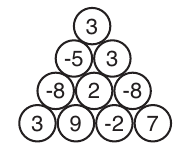| Submit | All submissions | Best solutions | Back to list |
BALLSAG - Ball Stacking Again |

The XYZ TV channel is developing again a new game show, where a contestant has to make a choice in order to get a prize. The game consists of a triangular stack of balls, each of them having an integer value, as the example shows.
The contestant must choose exactly one ball and his prize is the sum of the value of that ball and the balls directly on top of it. Notice that the prize can be negative!
Your friend is going to participate on the game show, and he wants you to develop a program that can tell the maximum prize possible.
Input
Each test case is described using several lines. The first line contains an integer N representing the number of rows of the stack (0 < N < 1001). The i-th of the next N lines contains i integers Bij (-1000 ≤ Bij ≤ 1000 for 1 ≤ j ≤ i ≤ N); the number Bij is the value of the j-th ball in the i-th row of the stack (the first row is the topmost one, and within each row the first ball if the leftmost one). After each test case there is a blank line.
The last test case is followed by a line containing one zero.
Output
For each test case output a line with an integer representing the maximum prize a contestant can make from the stack.
Example
Input: 2
-2
1 -10
3
1
-5 3
6 -4 1
0
Output: -1
5
Note:
On the first test case, the optimal solution is to take the ball with value 1, making you remove the ball with value -2, resulting in -1.
On the second test case the best option is to take the ball with value 1 on the bottom row, resulting in 1+3+1 = 5.
| Added by: | Paulo Costa |
| Date: | 2012-02-09 |
| Time limit: | 1s |
| Source limit: | 50000B |
| Memory limit: | 1536MB |
| Cluster: | Cube (Intel G860) |
| Languages: | All except: ASM64 |
| Resource: | ICMC-USP |
hide comments
|
|||||
|
2020-01-04 15:28:52 Simes
Similar to BALLLSTA. Last edit: 2020-01-04 15:29:08 |
|||||
|
2012-08-22 16:03:47 ZODI91
easy one :) |
|||||
|
2012-07-12 03:10:48 PANKAJ SAINI
hey, what is happening there, I used DP which cannot give a wrong answer, and tested on lot many test cases too... but getting wrong answer.. any special trick?? |
|||||
|
2012-06-28 21:30:11 npsabari
Any Tricky Case? Got many WA :( Though it is just DP! @problem setter: can you tell me in what case my code goes wrong.. code id: 7229327 EDIT: Little trick! Everyone getting WA, try to write bruteforce code and check with small inputs. Last edit: 2012-09-07 20:35:29 |
|||||
|
2012-06-06 07:23:13 Noszály Csaba
hi, I interpret the interpretation of Mitch as follows: for each element compute the union of (and the sum of its values) elements which can be reached by left up or right up moves (if the move can be done) + the value of actual node. The answer is the maximum of these values. Am i miss something? regards, ncs --> nevermind, found a mistake (return an int instead a bool in a method :() in my prog. Mitch's explanation is really fix the description. Last edit: 2012-06-06 08:20:19 |
|||||
|
2012-02-11 14:02:46 Mitch Schwartz
Yes, I also found the text confusing but managed to guess the meaning. The text uses the term "directly on top of" so I'll use the same term, even though it's a bit misleading. Consider this triangle 1 2 3 4 5 6 7 8 9 10 11 12 13 14 15 1 has no balls directly on top of it. 2 has 1 directly on top of it. 5 has 1,2,3 directly on top of it. 8 has 1,2,3,4,5 directly on top of it. 13 has 1,2,3,4,5,6,8,9 directly on top of it. Hope this helps everyone understand. @thanks man. Last edit: 2012-02-11 16:40:59 |
|||||
|
2012-02-11 08:41:32 Ikhaduri
fix the problem description, it's impossible to understand. |
|||||
|
2012-02-11 06:59:45 Tornike Mandzulashvili
What "on the top" means ? Last edit: 2012-02-11 07:00:03 |
|||||
|
2012-02-10 12:12:14 Devil D
in the figure ... what balls are on top of 9 ? |
|||||


 RSS
RSS